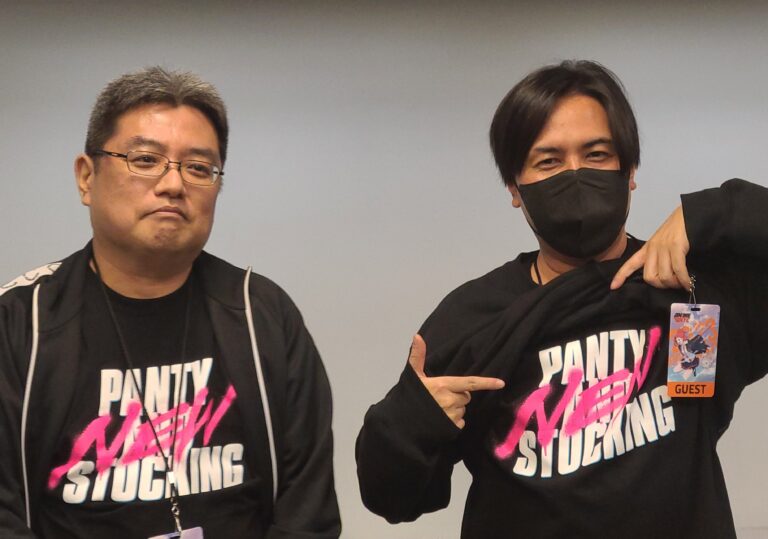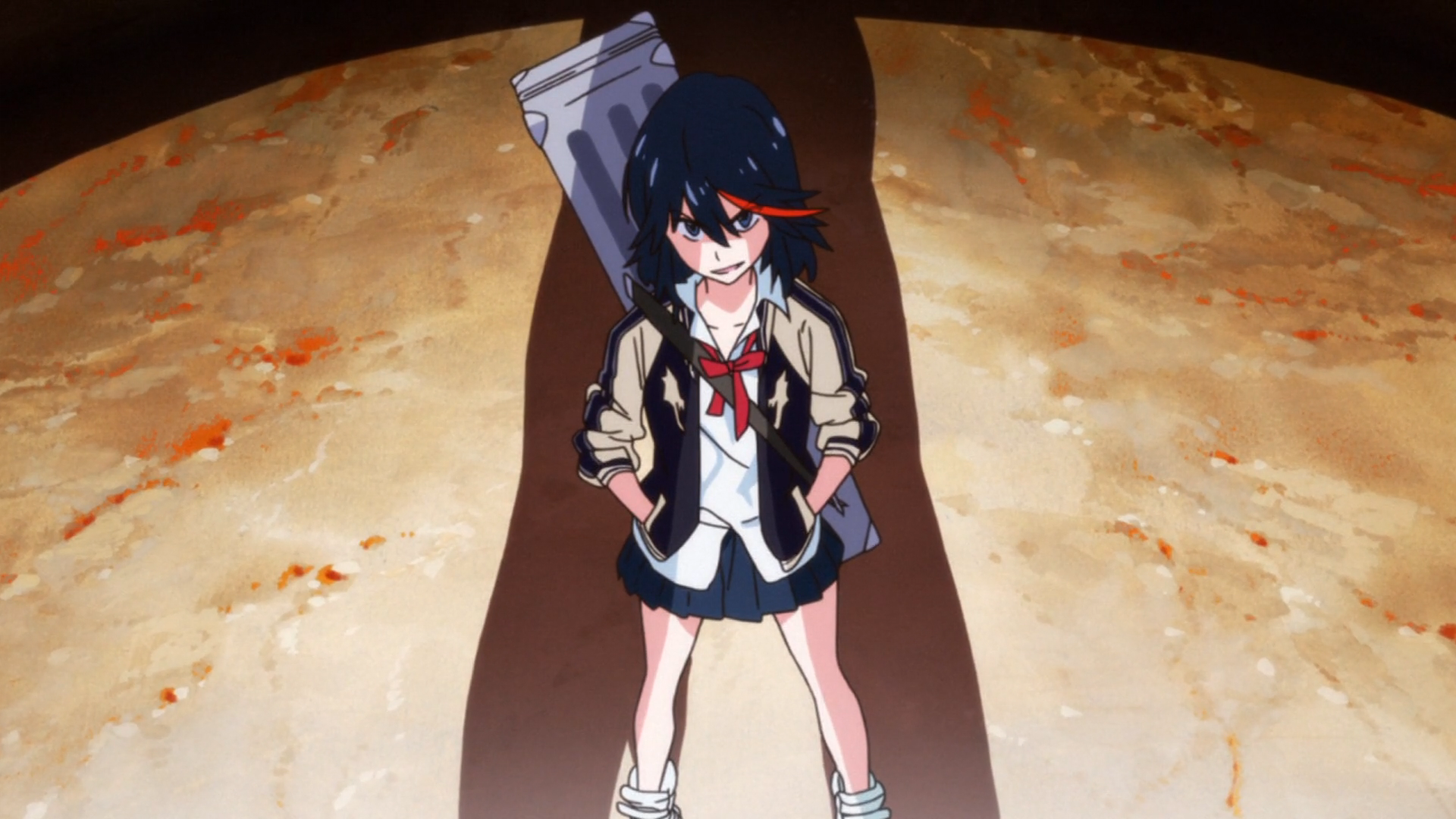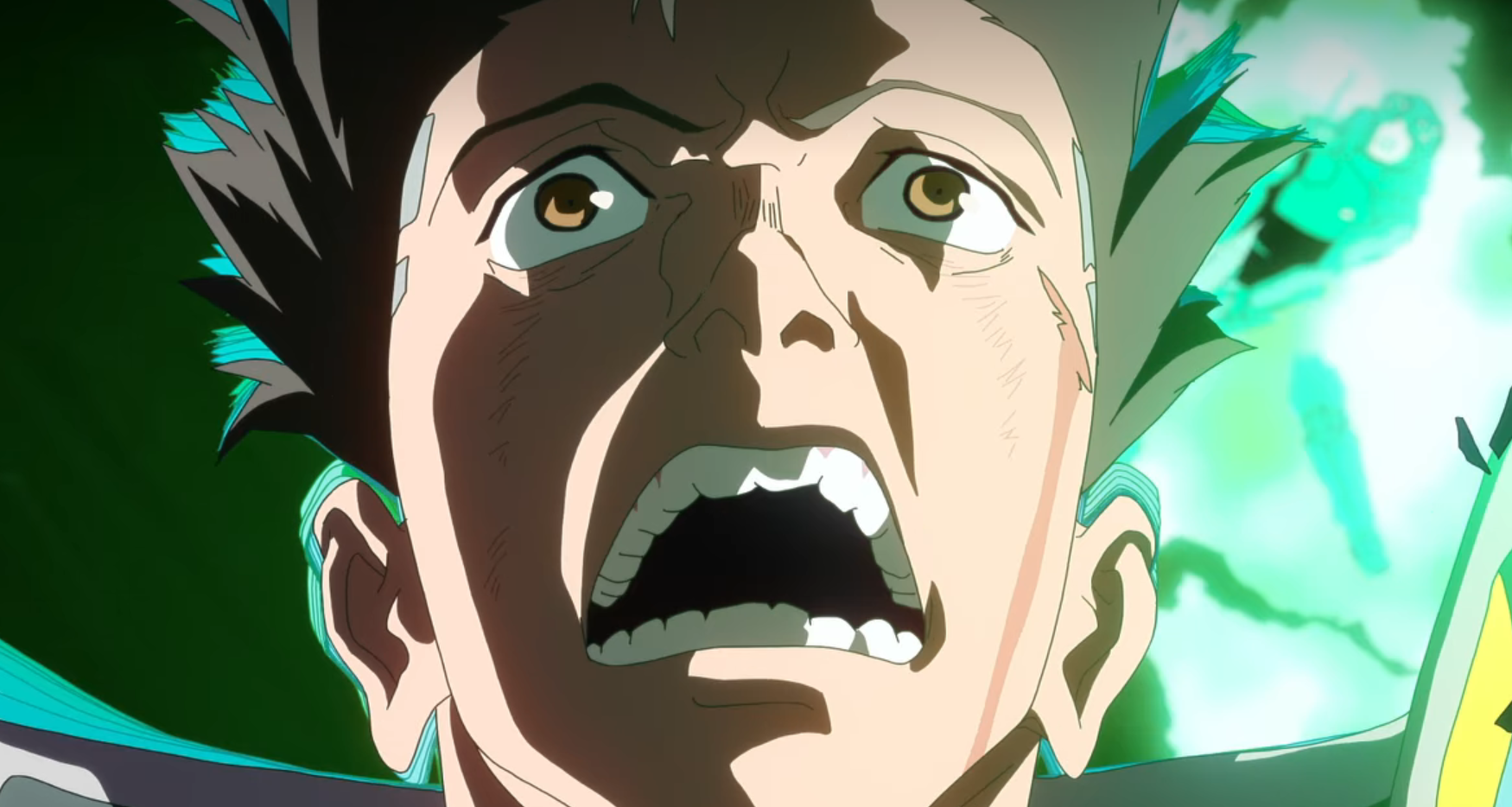As thousands of fans queued up around the block waiting for entry into Anime NYC, it’s first press conference featuring Studio TRIGGER kicked off. We had the privilege of being part of this conference, asking questions about the studio’s origins, its growth, its unique predisposition for original anime content, and some of the studio leadership’s quirks in terms of character design and animation. Director Hiroyuki Imaishi, one of the representatives from TRIGGER, established the studio in 2011 after the success of mecha anime GURREN LAGANN at Studio Gainax. Hiromi Wakabayashi, the other half of the contingent from TRIGGER, is also a previous member of Gainax as well as a production designer for GURREN LAGANN. Since TRIGGER’s inception, both have been instrumental in bringing many anime television shows, movies, and net animations to life, notably with a much higher proportion of original works than most any longstanding anime studio.
During the event, Imaishi and Wakabayashi painted a vivid picture that conveyed their unique perspective’s on TRIGGER’s past, present and future. While a wide variety of questions were asked by multiple members of the press, the conversation settled into three key areas of focus: Studio TRIGGER’s foundations, its growth, and its future aspirations as a production company.
Optimistic Origins
Over a decade ago in 2013, Studio TRIGGER released its first work, original anime television series KILL la KILL. At that time, the studio, its staff, and its style were incredibly fresh but also incredibly unique. The art and animation of KILL la KILL were recognizable to many as similar to works like GURREN LAGANN and sparked the beginning of a unique TRIGGER style that fans today can spot instantaneously. Imaishi took us back in time to explain how he saw the studio in its earliest days as it tackled an ambitious start.
“KILL la KILL was Studio TRIGGER’s first television anime series and it was the first original series that the studio took on as well […] It took us a very long time to [complete] the pre-production phase because everything was a complete, original title. And since the studio itself was new as well I didn’t have a very good grasp of the capabilities of the studio.”
Wakabayashi noted that he was pleasantly surprised at how well KILL la KILL was received overseas, especially in America.
“When we first started attending these overseas conventions, KILL la KILL‘s presentation is very old school anime. it’s what our generation grew up with. It feels nostalgic to us, but we weren’t expecting it to be received so positively to a Western audience.”
“The presentation and the expression is supposed to be retro-nostalgic for us, but maybe that felt very new to the Western audience, and maybe that’s why it was well-received.”
Both Imaishi and Wakabayashi stressed that originality is a key component both to how TRIGGER is able to maintain consistent quality and how they define their work to begin with. The studio produces much more original work than others, despite the difficulties in pre-production and mapping out every single bit of a title from start to finish. When the studio is looking for a new project, whether its based on a game, an original work, or a manga adaptation, one of the most important prerequisites is that the team has the freedom to influence how the project turns out. Imaishi noted that he what he looks for is “how much I’m able to enjoy a particular project” and Wakabayashi noted that, in the context of appraising potential partners, TRIGGER evaluates “how much they are willing to work with us to make it a TRIGGER project. If they were to offer to just animate their intellectual property, it obviously won’t work well with us.” To both of them, a work that has not been transformed or touched by TRIGGER’s style cannot be called a TRIGGER project, something that really resonates with the strength and consistency of the studio’s style across the many years. Imaishi made it clear how important this commitment to creativity is:
“There is a distinct difference between each project. Speaking of myself, personally I feel that I get bored very easily. I try to not get bored, so I try to do something new for every project so that I don’t get bored.
A Studio Maturing With Time
While many asked questions more about where TRIGGER started, with anime like KILL la KILL and my personal favorite When Supernatural Battles Became Commonplace, two newer projects in particular got a lot of focus. One was the 2022 web anime Cyberpunk: Edgerunners, a series with a notably serious tone in comparison to much of TRIGGER’s other work. The other is a revival of sorts; Panty & Stocking with Garterbelt which was originally produced by Gainax and premiered in 2010. Studio TRIGGER acquired the rights to the series in 2022, meaning Imaishi now has the opportunity to continue a project he directed while at Gainax.
“When I generally start work on a project, I usually commit my 100%. And because I give everything I have into a project I generally don’t have the urge or the need to create a follow-up season to a project. Panty & Stocking is an exception to this. It is a project that I’ve had the urge to […] continue to work on for the past 10 years.”
In a rather interesting set of timings, we can understand how TRIGGER is likely to approach its continuation of Panty & Stocking by examining Cyberpunk: Edgerunners. Cyberpunk: Edgerunners, to Imaishi’s point about giving 100% to a project, is a standalone series. Unlike many other TRIGGER projects, it doesn’t have quite as much comic relief involved. But, this became something of a test to Imaishi; being able to create a project that was more serious in comparison to other ones would demonstrate the studio’s growth and increasing skillset.
“For Cyberpunk: Edgerunners, obviously there’s about 10+ years between that and Kill la Kill. So the studio was a lot more seasoned as well, and I had a better grasp of what my studio was capable of. Everyone in each department was a lot more optimized as well, so I felt that we were able to shorten the production time by a lot without losing the quality of the finished product. And it also helped that Cyberpunk was a pre-existing idea.”
Studio TRIGGER passed that test with flying colors.
The Near and Far Future for Studio TRIGGER
Ultimately, it was quite clear that Studio TRIGGER had grown to wield an incredibly diverse set of skills and abilities wrapped in a consistent set of stylistic preferences and attention to creative freedom for the team. Even across projects with vastly differently subject matter, like GURREN LAGANN, KILL la KILL, and Cyberpunk: Edgerunners, similar themes and aesthetics appear. Characters with a rebellious spirit will have or acquire spiky hair. Heroes will fight using actual mecha or clothing, powers, or cybernetic bodies that end up functioning like mecha.
“I grew up with anime for 30 years. If I had to choose one genre that’s probably my most favorite, its probably mecha series. […] If I could choose what makes anime more interesting I’d probably say its the introduction of a mecha. That’s probably the reason why I lean back to what I enjoy the most,” Imaishi said, thinking about the patterns throughout the works he’s been involved with over the years.
We ended with some musings about future projects the two would be interested in. Wakabayashi explained that Studio TRIGGER has already been fortunate enough to collaborate with a lot of projects they wanted to, like Toy Story and Star Wars. Amusingly, the franchise he eventually settled on wanting to adapt was Fast and Furious, suggesting a series called Fast and Furious: T, with a “T” for TRIGGER. We at Anime Corner were incredibly thankful to hear the thoughts of Imaishi and Wakabayashi, especially surprising ones like this. Early in the conference, Wakabayashi explained that TRIGGER always creates the story that they want to tell.
“We don’t really follow a trend. We try to do what we enjoy the most.”
Images via Crunchyroll, Netflix
©TRIGGER, Kazuki Nakashima / KILL la KILL Partnership, Cyberpunk: Edgerunners © 2022 CD PROJEKT S.A.



Participate In Discussions